Advanced Financial Accounting: Enron Scandal Analysis, Spring 2020
VerifiedAdded on 2022/09/14
|11
|3204
|15
Homework Assignment
AI Summary
This assignment delves into the Enron scandal, examining the roles of key executives, the auditing firm Arthur Andersen, and the Securities and Exchange Commission (SEC). It analyzes how executives like Kenneth Lay, Andrew Fastow, and Jeffrey Skilling manipulated financial reporting, created a culture of rule-breaking, and used innovative accounting practices like mark-to-market to inflate profits. The assignment explores how Arthur Andersen failed to perform its auditing responsibilities and how the SEC's practices contributed to the crisis. It further discusses Enron's use of Special Purpose Entities (SPEs) and the manipulation of financial statements to create a false impression of financial health. The analysis highlights how the company took advantage of accounting loopholes and the impact on investors and the public. The assignment also examines the Enron Online platform, the company's rapid unraveling, and the public's loss of faith in the company. The student analyzes the manipulation of earnings and the use of common stock as part of the capitalization of Raptor organizations. Overall, the assignment provides a comprehensive overview of the Enron scandal, the accounting practices, and the failures that led to the company's downfall.
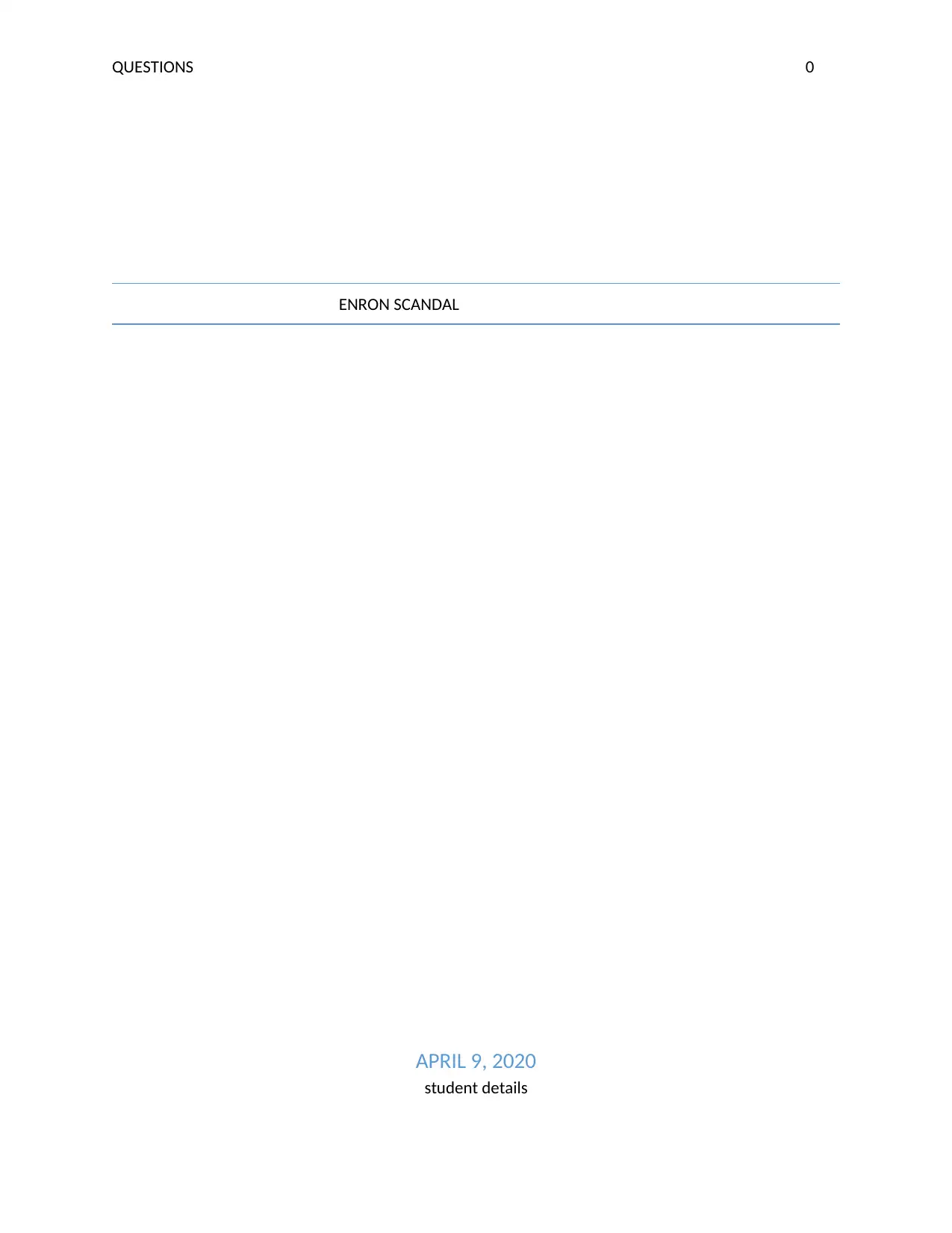
QUESTIONS 0
ENRON SCANDAL
APRIL 9, 2020
student details
ENRON SCANDAL
APRIL 9, 2020
student details
Paraphrase This Document
Need a fresh take? Get an instant paraphrase of this document with our AI Paraphraser
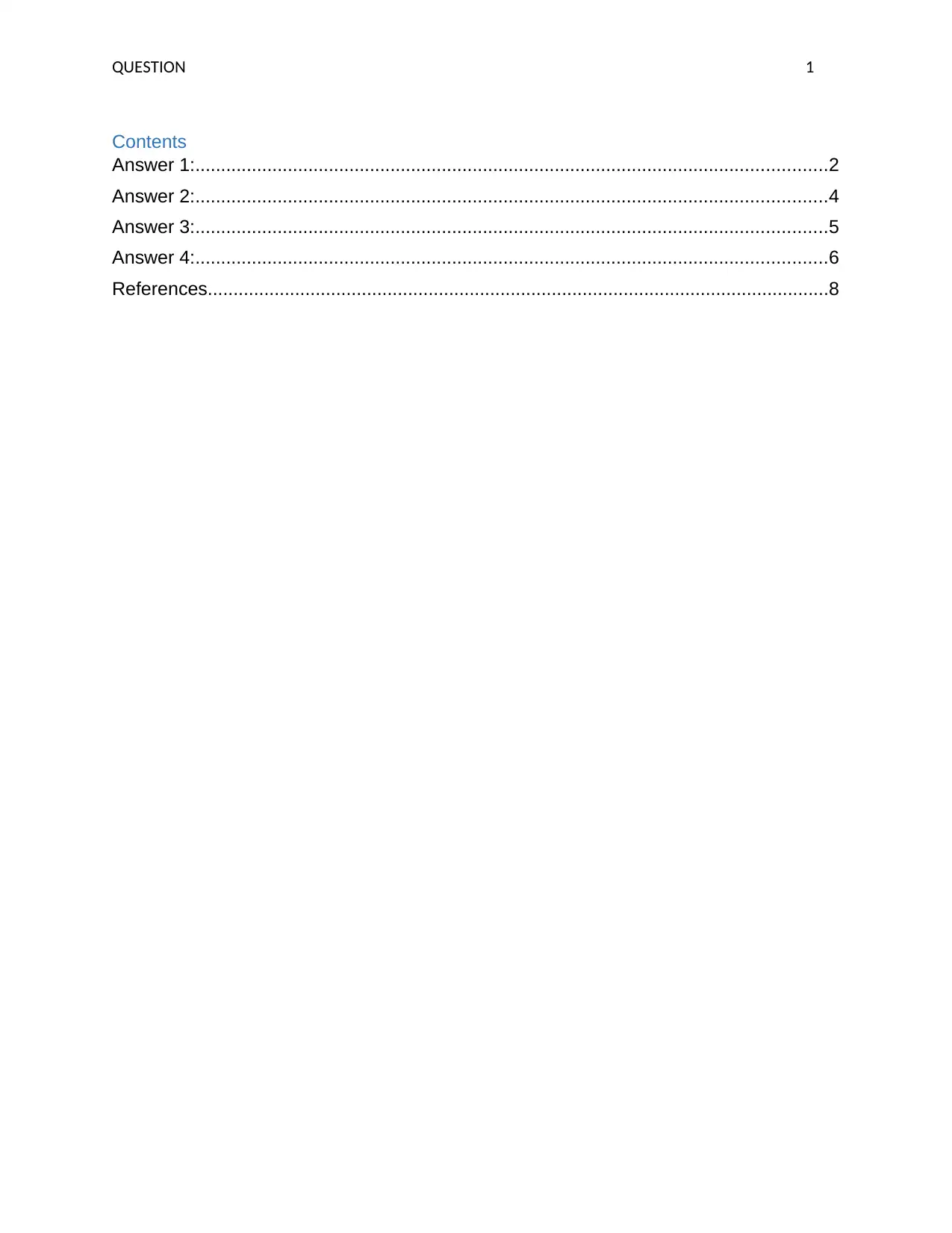
QUESTION 1
Contents
Answer 1:...........................................................................................................................2
Answer 2:...........................................................................................................................4
Answer 3:...........................................................................................................................5
Answer 4:...........................................................................................................................6
References.........................................................................................................................8
Contents
Answer 1:...........................................................................................................................2
Answer 2:...........................................................................................................................4
Answer 3:...........................................................................................................................5
Answer 4:...........................................................................................................................6
References.........................................................................................................................8
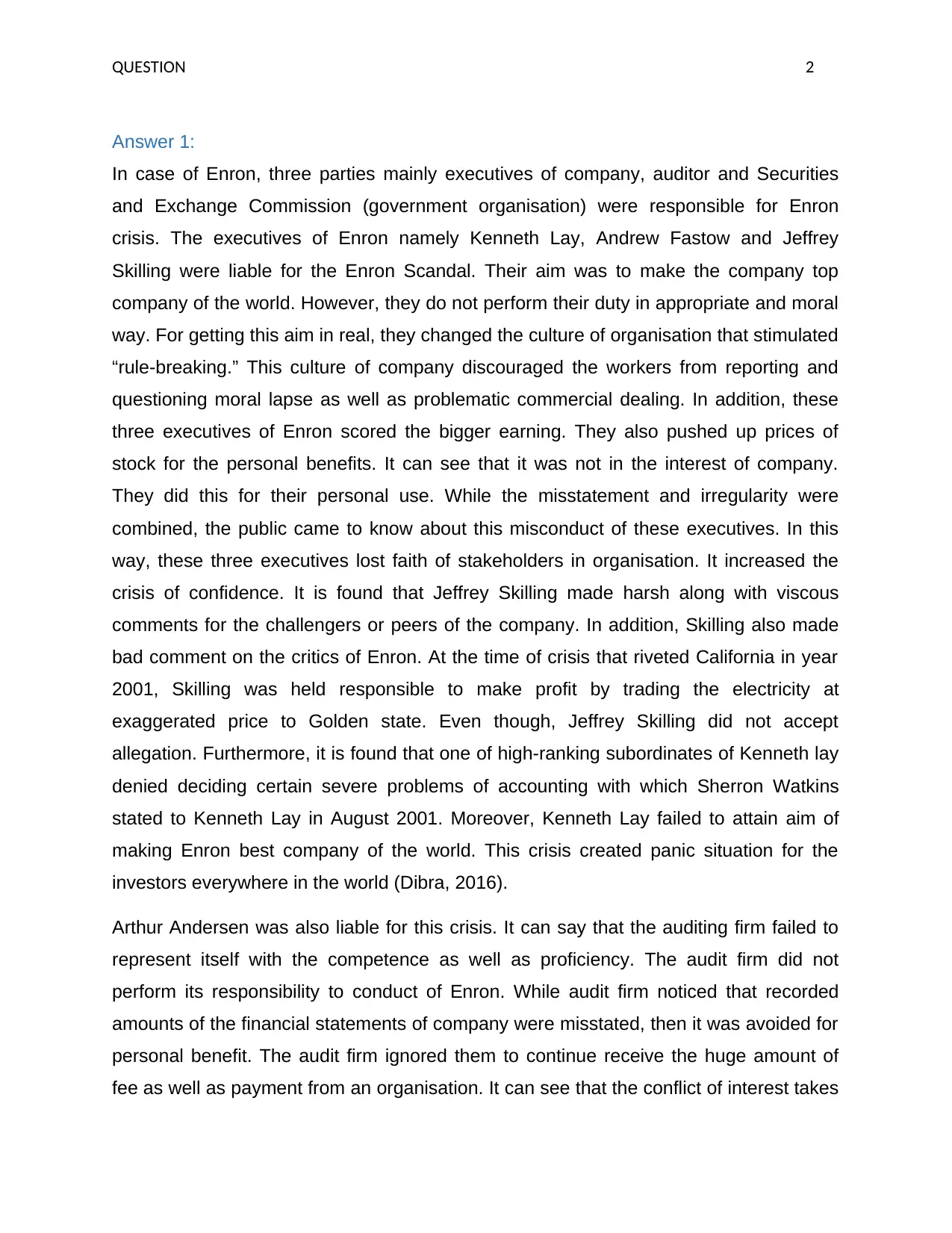
QUESTION 2
Answer 1:
In case of Enron, three parties mainly executives of company, auditor and Securities
and Exchange Commission (government organisation) were responsible for Enron
crisis. The executives of Enron namely Kenneth Lay, Andrew Fastow and Jeffrey
Skilling were liable for the Enron Scandal. Their aim was to make the company top
company of the world. However, they do not perform their duty in appropriate and moral
way. For getting this aim in real, they changed the culture of organisation that stimulated
“rule-breaking.” This culture of company discouraged the workers from reporting and
questioning moral lapse as well as problematic commercial dealing. In addition, these
three executives of Enron scored the bigger earning. They also pushed up prices of
stock for the personal benefits. It can see that it was not in the interest of company.
They did this for their personal use. While the misstatement and irregularity were
combined, the public came to know about this misconduct of these executives. In this
way, these three executives lost faith of stakeholders in organisation. It increased the
crisis of confidence. It is found that Jeffrey Skilling made harsh along with viscous
comments for the challengers or peers of the company. In addition, Skilling also made
bad comment on the critics of Enron. At the time of crisis that riveted California in year
2001, Skilling was held responsible to make profit by trading the electricity at
exaggerated price to Golden state. Even though, Jeffrey Skilling did not accept
allegation. Furthermore, it is found that one of high-ranking subordinates of Kenneth lay
denied deciding certain severe problems of accounting with which Sherron Watkins
stated to Kenneth Lay in August 2001. Moreover, Kenneth Lay failed to attain aim of
making Enron best company of the world. This crisis created panic situation for the
investors everywhere in the world (Dibra, 2016).
Arthur Andersen was also liable for this crisis. It can say that the auditing firm failed to
represent itself with the competence as well as proficiency. The audit firm did not
perform its responsibility to conduct of Enron. While audit firm noticed that recorded
amounts of the financial statements of company were misstated, then it was avoided for
personal benefit. The audit firm ignored them to continue receive the huge amount of
fee as well as payment from an organisation. It can see that the conflict of interest takes
Answer 1:
In case of Enron, three parties mainly executives of company, auditor and Securities
and Exchange Commission (government organisation) were responsible for Enron
crisis. The executives of Enron namely Kenneth Lay, Andrew Fastow and Jeffrey
Skilling were liable for the Enron Scandal. Their aim was to make the company top
company of the world. However, they do not perform their duty in appropriate and moral
way. For getting this aim in real, they changed the culture of organisation that stimulated
“rule-breaking.” This culture of company discouraged the workers from reporting and
questioning moral lapse as well as problematic commercial dealing. In addition, these
three executives of Enron scored the bigger earning. They also pushed up prices of
stock for the personal benefits. It can see that it was not in the interest of company.
They did this for their personal use. While the misstatement and irregularity were
combined, the public came to know about this misconduct of these executives. In this
way, these three executives lost faith of stakeholders in organisation. It increased the
crisis of confidence. It is found that Jeffrey Skilling made harsh along with viscous
comments for the challengers or peers of the company. In addition, Skilling also made
bad comment on the critics of Enron. At the time of crisis that riveted California in year
2001, Skilling was held responsible to make profit by trading the electricity at
exaggerated price to Golden state. Even though, Jeffrey Skilling did not accept
allegation. Furthermore, it is found that one of high-ranking subordinates of Kenneth lay
denied deciding certain severe problems of accounting with which Sherron Watkins
stated to Kenneth Lay in August 2001. Moreover, Kenneth Lay failed to attain aim of
making Enron best company of the world. This crisis created panic situation for the
investors everywhere in the world (Dibra, 2016).
Arthur Andersen was also liable for this crisis. It can say that the auditing firm failed to
represent itself with the competence as well as proficiency. The audit firm did not
perform its responsibility to conduct of Enron. While audit firm noticed that recorded
amounts of the financial statements of company were misstated, then it was avoided for
personal benefit. The audit firm ignored them to continue receive the huge amount of
fee as well as payment from an organisation. It can see that the conflict of interest takes
⊘ This is a preview!⊘
Do you want full access?
Subscribe today to unlock all pages.

Trusted by 1+ million students worldwide
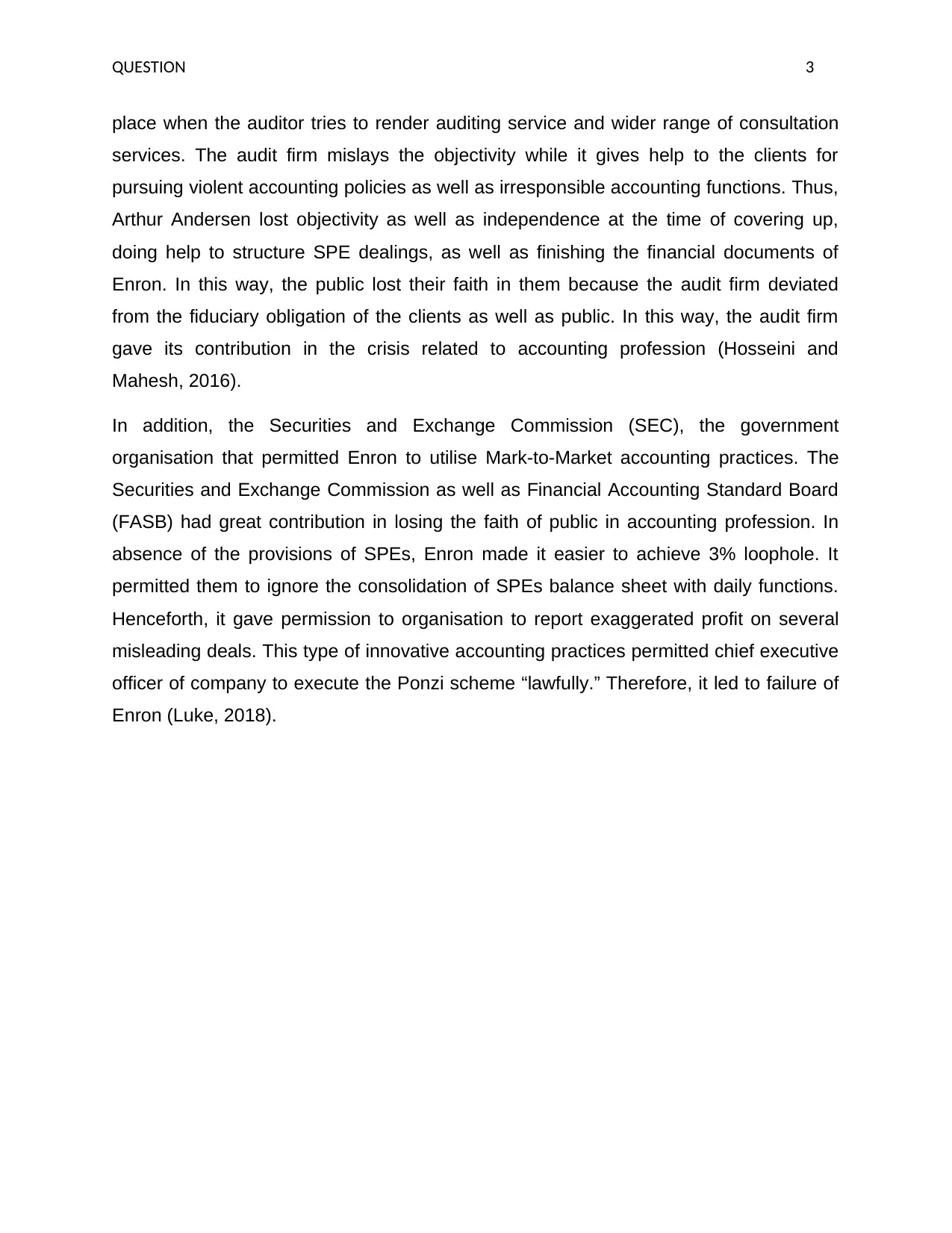
QUESTION 3
place when the auditor tries to render auditing service and wider range of consultation
services. The audit firm mislays the objectivity while it gives help to the clients for
pursuing violent accounting policies as well as irresponsible accounting functions. Thus,
Arthur Andersen lost objectivity as well as independence at the time of covering up,
doing help to structure SPE dealings, as well as finishing the financial documents of
Enron. In this way, the public lost their faith in them because the audit firm deviated
from the fiduciary obligation of the clients as well as public. In this way, the audit firm
gave its contribution in the crisis related to accounting profession (Hosseini and
Mahesh, 2016).
In addition, the Securities and Exchange Commission (SEC), the government
organisation that permitted Enron to utilise Mark-to-Market accounting practices. The
Securities and Exchange Commission as well as Financial Accounting Standard Board
(FASB) had great contribution in losing the faith of public in accounting profession. In
absence of the provisions of SPEs, Enron made it easier to achieve 3% loophole. It
permitted them to ignore the consolidation of SPEs balance sheet with daily functions.
Henceforth, it gave permission to organisation to report exaggerated profit on several
misleading deals. This type of innovative accounting practices permitted chief executive
officer of company to execute the Ponzi scheme “lawfully.” Therefore, it led to failure of
Enron (Luke, 2018).
place when the auditor tries to render auditing service and wider range of consultation
services. The audit firm mislays the objectivity while it gives help to the clients for
pursuing violent accounting policies as well as irresponsible accounting functions. Thus,
Arthur Andersen lost objectivity as well as independence at the time of covering up,
doing help to structure SPE dealings, as well as finishing the financial documents of
Enron. In this way, the public lost their faith in them because the audit firm deviated
from the fiduciary obligation of the clients as well as public. In this way, the audit firm
gave its contribution in the crisis related to accounting profession (Hosseini and
Mahesh, 2016).
In addition, the Securities and Exchange Commission (SEC), the government
organisation that permitted Enron to utilise Mark-to-Market accounting practices. The
Securities and Exchange Commission as well as Financial Accounting Standard Board
(FASB) had great contribution in losing the faith of public in accounting profession. In
absence of the provisions of SPEs, Enron made it easier to achieve 3% loophole. It
permitted them to ignore the consolidation of SPEs balance sheet with daily functions.
Henceforth, it gave permission to organisation to report exaggerated profit on several
misleading deals. This type of innovative accounting practices permitted chief executive
officer of company to execute the Ponzi scheme “lawfully.” Therefore, it led to failure of
Enron (Luke, 2018).
Paraphrase This Document
Need a fresh take? Get an instant paraphrase of this document with our AI Paraphraser
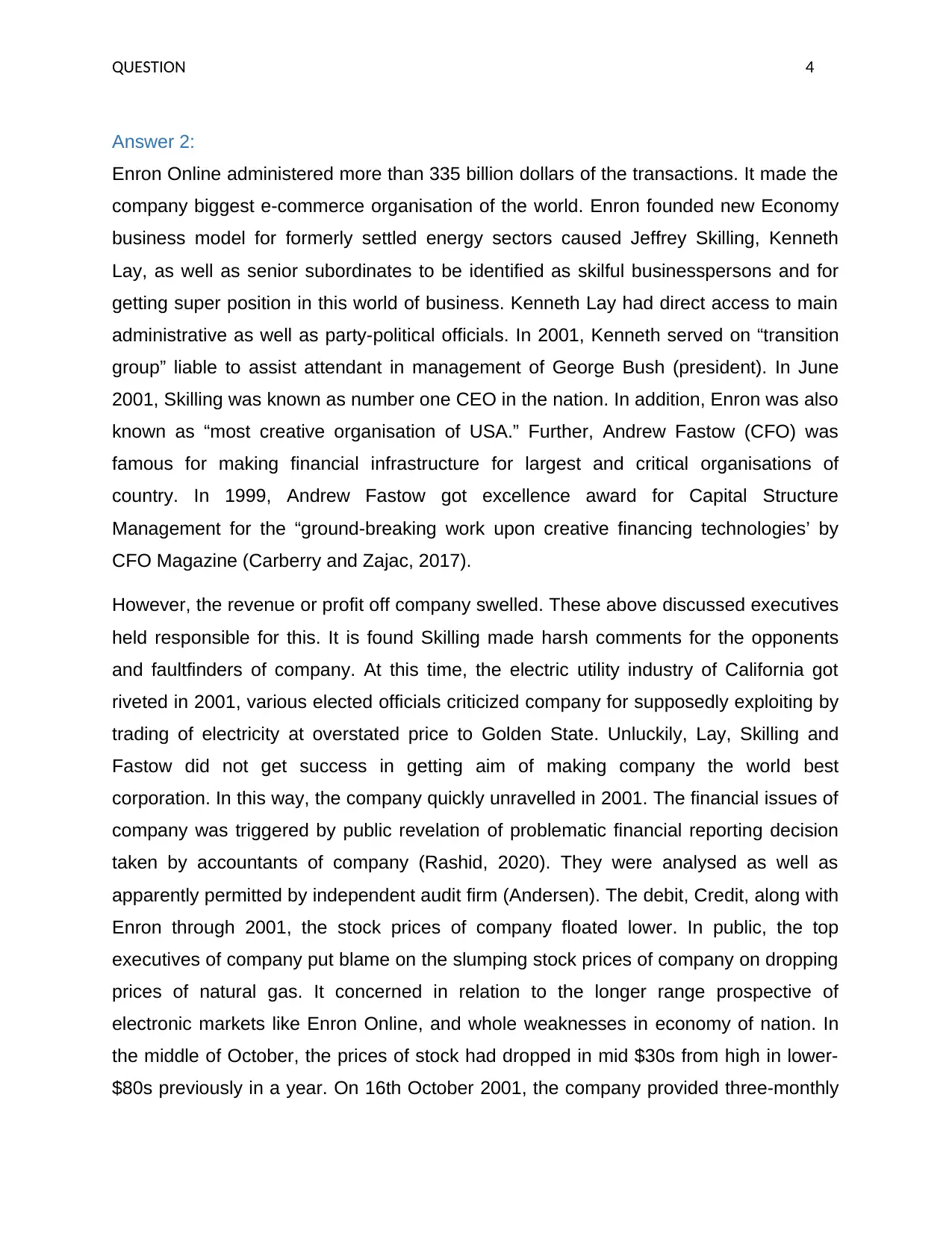
QUESTION 4
Answer 2:
Enron Online administered more than 335 billion dollars of the transactions. It made the
company biggest e-commerce organisation of the world. Enron founded new Economy
business model for formerly settled energy sectors caused Jeffrey Skilling, Kenneth
Lay, as well as senior subordinates to be identified as skilful businesspersons and for
getting super position in this world of business. Kenneth Lay had direct access to main
administrative as well as party-political officials. In 2001, Kenneth served on “transition
group” liable to assist attendant in management of George Bush (president). In June
2001, Skilling was known as number one CEO in the nation. In addition, Enron was also
known as “most creative organisation of USA.” Further, Andrew Fastow (CFO) was
famous for making financial infrastructure for largest and critical organisations of
country. In 1999, Andrew Fastow got excellence award for Capital Structure
Management for the “ground-breaking work upon creative financing technologies’ by
CFO Magazine (Carberry and Zajac, 2017).
However, the revenue or profit off company swelled. These above discussed executives
held responsible for this. It is found Skilling made harsh comments for the opponents
and faultfinders of company. At this time, the electric utility industry of California got
riveted in 2001, various elected officials criticized company for supposedly exploiting by
trading of electricity at overstated price to Golden State. Unluckily, Lay, Skilling and
Fastow did not get success in getting aim of making company the world best
corporation. In this way, the company quickly unravelled in 2001. The financial issues of
company was triggered by public revelation of problematic financial reporting decision
taken by accountants of company (Rashid, 2020). They were analysed as well as
apparently permitted by independent audit firm (Andersen). The debit, Credit, along with
Enron through 2001, the stock prices of company floated lower. In public, the top
executives of company put blame on the slumping stock prices of company on dropping
prices of natural gas. It concerned in relation to the longer range prospective of
electronic markets like Enron Online, and whole weaknesses in economy of nation. In
the middle of October, the prices of stock had dropped in mid $30s from high in lower-
$80s previously in a year. On 16th October 2001, the company provided three-monthly
Answer 2:
Enron Online administered more than 335 billion dollars of the transactions. It made the
company biggest e-commerce organisation of the world. Enron founded new Economy
business model for formerly settled energy sectors caused Jeffrey Skilling, Kenneth
Lay, as well as senior subordinates to be identified as skilful businesspersons and for
getting super position in this world of business. Kenneth Lay had direct access to main
administrative as well as party-political officials. In 2001, Kenneth served on “transition
group” liable to assist attendant in management of George Bush (president). In June
2001, Skilling was known as number one CEO in the nation. In addition, Enron was also
known as “most creative organisation of USA.” Further, Andrew Fastow (CFO) was
famous for making financial infrastructure for largest and critical organisations of
country. In 1999, Andrew Fastow got excellence award for Capital Structure
Management for the “ground-breaking work upon creative financing technologies’ by
CFO Magazine (Carberry and Zajac, 2017).
However, the revenue or profit off company swelled. These above discussed executives
held responsible for this. It is found Skilling made harsh comments for the opponents
and faultfinders of company. At this time, the electric utility industry of California got
riveted in 2001, various elected officials criticized company for supposedly exploiting by
trading of electricity at overstated price to Golden State. Unluckily, Lay, Skilling and
Fastow did not get success in getting aim of making company the world best
corporation. In this way, the company quickly unravelled in 2001. The financial issues of
company was triggered by public revelation of problematic financial reporting decision
taken by accountants of company (Rashid, 2020). They were analysed as well as
apparently permitted by independent audit firm (Andersen). The debit, Credit, along with
Enron through 2001, the stock prices of company floated lower. In public, the top
executives of company put blame on the slumping stock prices of company on dropping
prices of natural gas. It concerned in relation to the longer range prospective of
electronic markets like Enron Online, and whole weaknesses in economy of nation. In
the middle of October, the prices of stock had dropped in mid $30s from high in lower-
$80s previously in a year. On 16th October 2001, the company provided three-monthly
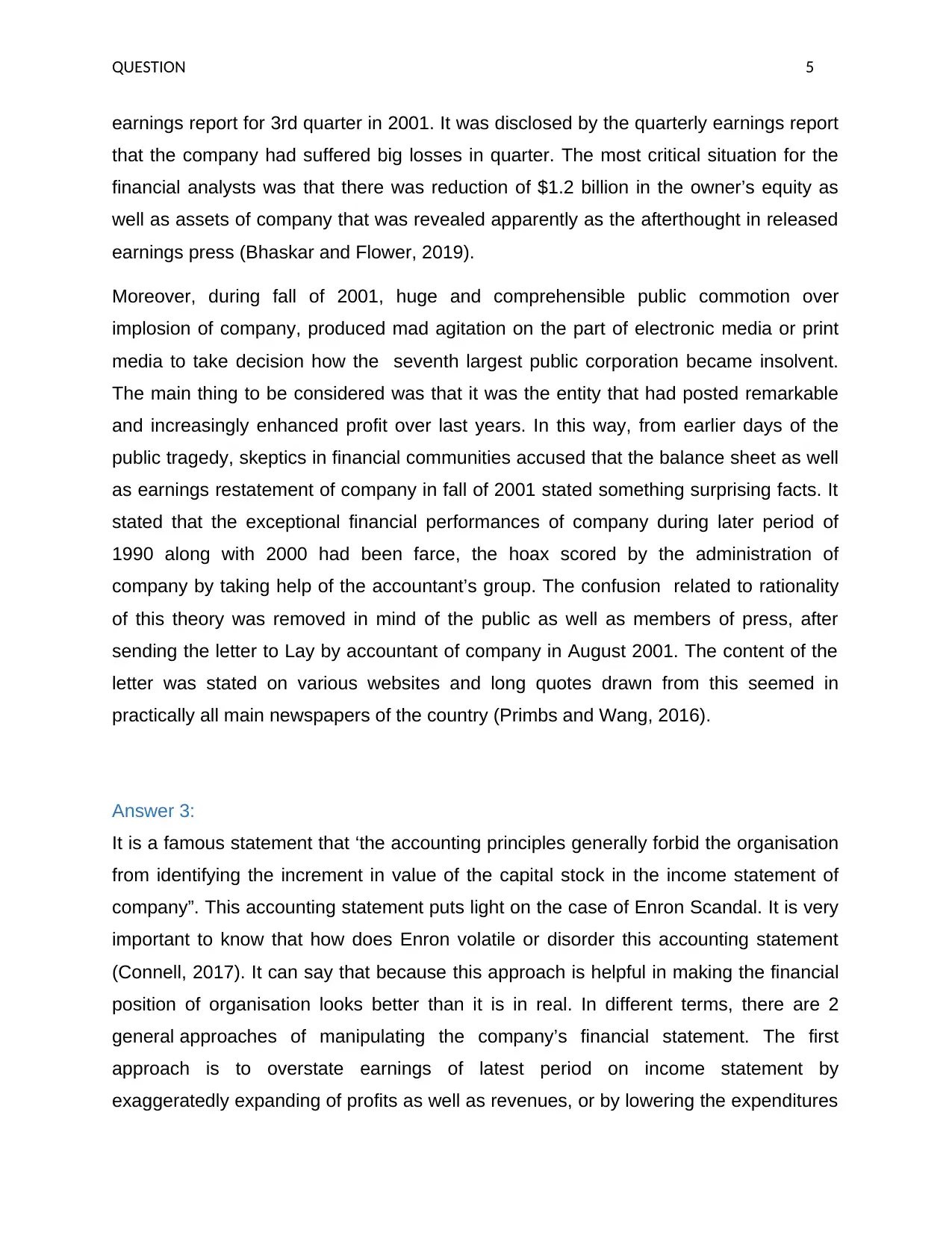
QUESTION 5
earnings report for 3rd quarter in 2001. It was disclosed by the quarterly earnings report
that the company had suffered big losses in quarter. The most critical situation for the
financial analysts was that there was reduction of $1.2 billion in the owner’s equity as
well as assets of company that was revealed apparently as the afterthought in released
earnings press (Bhaskar and Flower, 2019).
Moreover, during fall of 2001, huge and comprehensible public commotion over
implosion of company, produced mad agitation on the part of electronic media or print
media to take decision how the seventh largest public corporation became insolvent.
The main thing to be considered was that it was the entity that had posted remarkable
and increasingly enhanced profit over last years. In this way, from earlier days of the
public tragedy, skeptics in financial communities accused that the balance sheet as well
as earnings restatement of company in fall of 2001 stated something surprising facts. It
stated that the exceptional financial performances of company during later period of
1990 along with 2000 had been farce, the hoax scored by the administration of
company by taking help of the accountant’s group. The confusion related to rationality
of this theory was removed in mind of the public as well as members of press, after
sending the letter to Lay by accountant of company in August 2001. The content of the
letter was stated on various websites and long quotes drawn from this seemed in
practically all main newspapers of the country (Primbs and Wang, 2016).
Answer 3:
It is a famous statement that ‘the accounting principles generally forbid the organisation
from identifying the increment in value of the capital stock in the income statement of
company”. This accounting statement puts light on the case of Enron Scandal. It is very
important to know that how does Enron volatile or disorder this accounting statement
(Connell, 2017). It can say that because this approach is helpful in making the financial
position of organisation looks better than it is in real. In different terms, there are 2
general approaches of manipulating the company’s financial statement. The first
approach is to overstate earnings of latest period on income statement by
exaggeratedly expanding of profits as well as revenues, or by lowering the expenditures
earnings report for 3rd quarter in 2001. It was disclosed by the quarterly earnings report
that the company had suffered big losses in quarter. The most critical situation for the
financial analysts was that there was reduction of $1.2 billion in the owner’s equity as
well as assets of company that was revealed apparently as the afterthought in released
earnings press (Bhaskar and Flower, 2019).
Moreover, during fall of 2001, huge and comprehensible public commotion over
implosion of company, produced mad agitation on the part of electronic media or print
media to take decision how the seventh largest public corporation became insolvent.
The main thing to be considered was that it was the entity that had posted remarkable
and increasingly enhanced profit over last years. In this way, from earlier days of the
public tragedy, skeptics in financial communities accused that the balance sheet as well
as earnings restatement of company in fall of 2001 stated something surprising facts. It
stated that the exceptional financial performances of company during later period of
1990 along with 2000 had been farce, the hoax scored by the administration of
company by taking help of the accountant’s group. The confusion related to rationality
of this theory was removed in mind of the public as well as members of press, after
sending the letter to Lay by accountant of company in August 2001. The content of the
letter was stated on various websites and long quotes drawn from this seemed in
practically all main newspapers of the country (Primbs and Wang, 2016).
Answer 3:
It is a famous statement that ‘the accounting principles generally forbid the organisation
from identifying the increment in value of the capital stock in the income statement of
company”. This accounting statement puts light on the case of Enron Scandal. It is very
important to know that how does Enron volatile or disorder this accounting statement
(Connell, 2017). It can say that because this approach is helpful in making the financial
position of organisation looks better than it is in real. In different terms, there are 2
general approaches of manipulating the company’s financial statement. The first
approach is to overstate earnings of latest period on income statement by
exaggeratedly expanding of profits as well as revenues, or by lowering the expenditures
⊘ This is a preview!⊘
Do you want full access?
Subscribe today to unlock all pages.

Trusted by 1+ million students worldwide
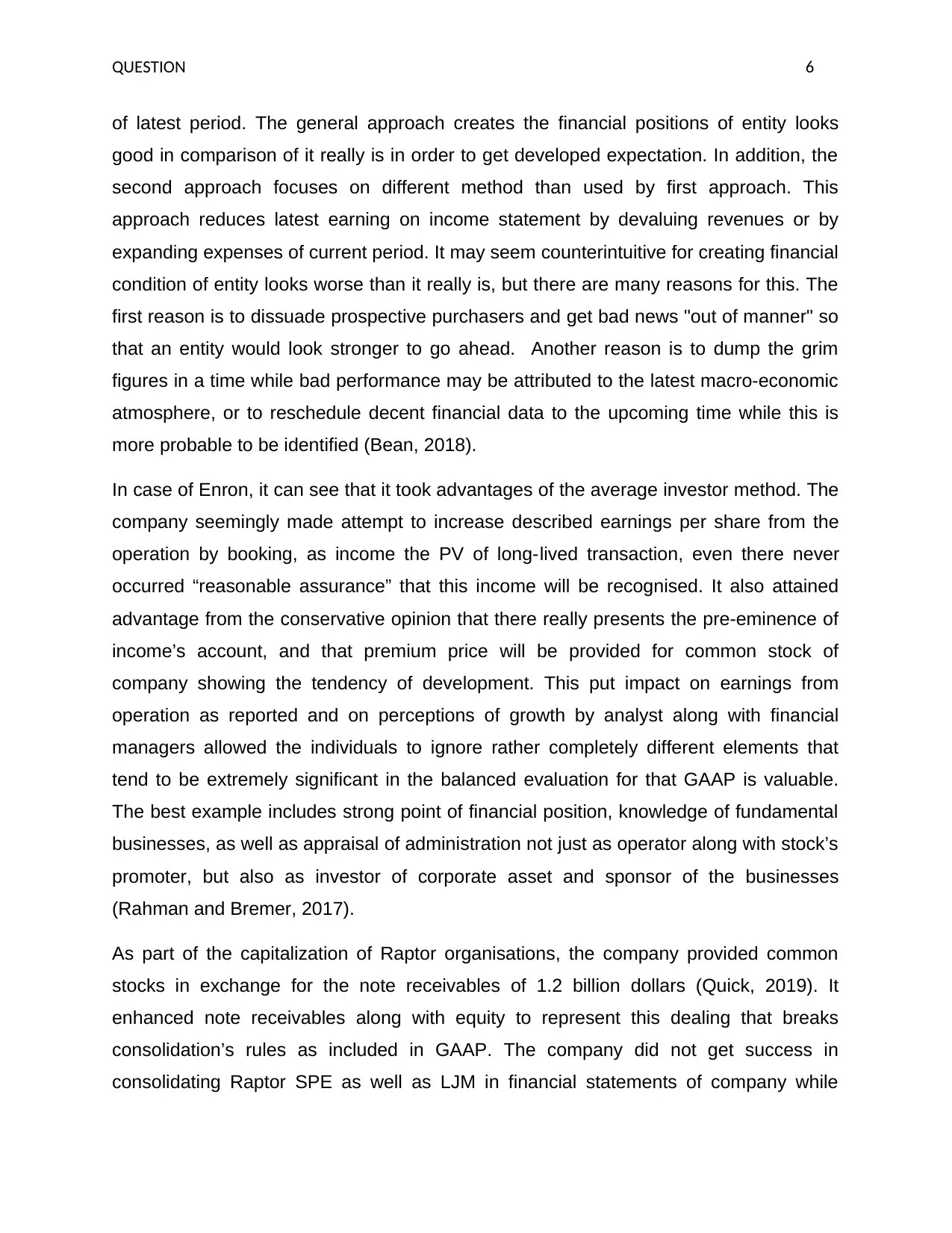
QUESTION 6
of latest period. The general approach creates the financial positions of entity looks
good in comparison of it really is in order to get developed expectation. In addition, the
second approach focuses on different method than used by first approach. This
approach reduces latest earning on income statement by devaluing revenues or by
expanding expenses of current period. It may seem counterintuitive for creating financial
condition of entity looks worse than it really is, but there are many reasons for this. The
first reason is to dissuade prospective purchasers and get bad news "out of manner" so
that an entity would look stronger to go ahead. Another reason is to dump the grim
figures in a time while bad performance may be attributed to the latest macro-economic
atmosphere, or to reschedule decent financial data to the upcoming time while this is
more probable to be identified (Bean, 2018).
In case of Enron, it can see that it took advantages of the average investor method. The
company seemingly made attempt to increase described earnings per share from the
operation by booking, as income the PV of long-lived transaction, even there never
occurred “reasonable assurance” that this income will be recognised. It also attained
advantage from the conservative opinion that there really presents the pre-eminence of
income’s account, and that premium price will be provided for common stock of
company showing the tendency of development. This put impact on earnings from
operation as reported and on perceptions of growth by analyst along with financial
managers allowed the individuals to ignore rather completely different elements that
tend to be extremely significant in the balanced evaluation for that GAAP is valuable.
The best example includes strong point of financial position, knowledge of fundamental
businesses, as well as appraisal of administration not just as operator along with stock’s
promoter, but also as investor of corporate asset and sponsor of the businesses
(Rahman and Bremer, 2017).
As part of the capitalization of Raptor organisations, the company provided common
stocks in exchange for the note receivables of 1.2 billion dollars (Quick, 2019). It
enhanced note receivables along with equity to represent this dealing that breaks
consolidation’s rules as included in GAAP. The company did not get success in
consolidating Raptor SPE as well as LJM in financial statements of company while
of latest period. The general approach creates the financial positions of entity looks
good in comparison of it really is in order to get developed expectation. In addition, the
second approach focuses on different method than used by first approach. This
approach reduces latest earning on income statement by devaluing revenues or by
expanding expenses of current period. It may seem counterintuitive for creating financial
condition of entity looks worse than it really is, but there are many reasons for this. The
first reason is to dissuade prospective purchasers and get bad news "out of manner" so
that an entity would look stronger to go ahead. Another reason is to dump the grim
figures in a time while bad performance may be attributed to the latest macro-economic
atmosphere, or to reschedule decent financial data to the upcoming time while this is
more probable to be identified (Bean, 2018).
In case of Enron, it can see that it took advantages of the average investor method. The
company seemingly made attempt to increase described earnings per share from the
operation by booking, as income the PV of long-lived transaction, even there never
occurred “reasonable assurance” that this income will be recognised. It also attained
advantage from the conservative opinion that there really presents the pre-eminence of
income’s account, and that premium price will be provided for common stock of
company showing the tendency of development. This put impact on earnings from
operation as reported and on perceptions of growth by analyst along with financial
managers allowed the individuals to ignore rather completely different elements that
tend to be extremely significant in the balanced evaluation for that GAAP is valuable.
The best example includes strong point of financial position, knowledge of fundamental
businesses, as well as appraisal of administration not just as operator along with stock’s
promoter, but also as investor of corporate asset and sponsor of the businesses
(Rahman and Bremer, 2017).
As part of the capitalization of Raptor organisations, the company provided common
stocks in exchange for the note receivables of 1.2 billion dollars (Quick, 2019). It
enhanced note receivables along with equity to represent this dealing that breaks
consolidation’s rules as included in GAAP. The company did not get success in
consolidating Raptor SPE as well as LJM in financial statements of company while
Paraphrase This Document
Need a fresh take? Get an instant paraphrase of this document with our AI Paraphraser
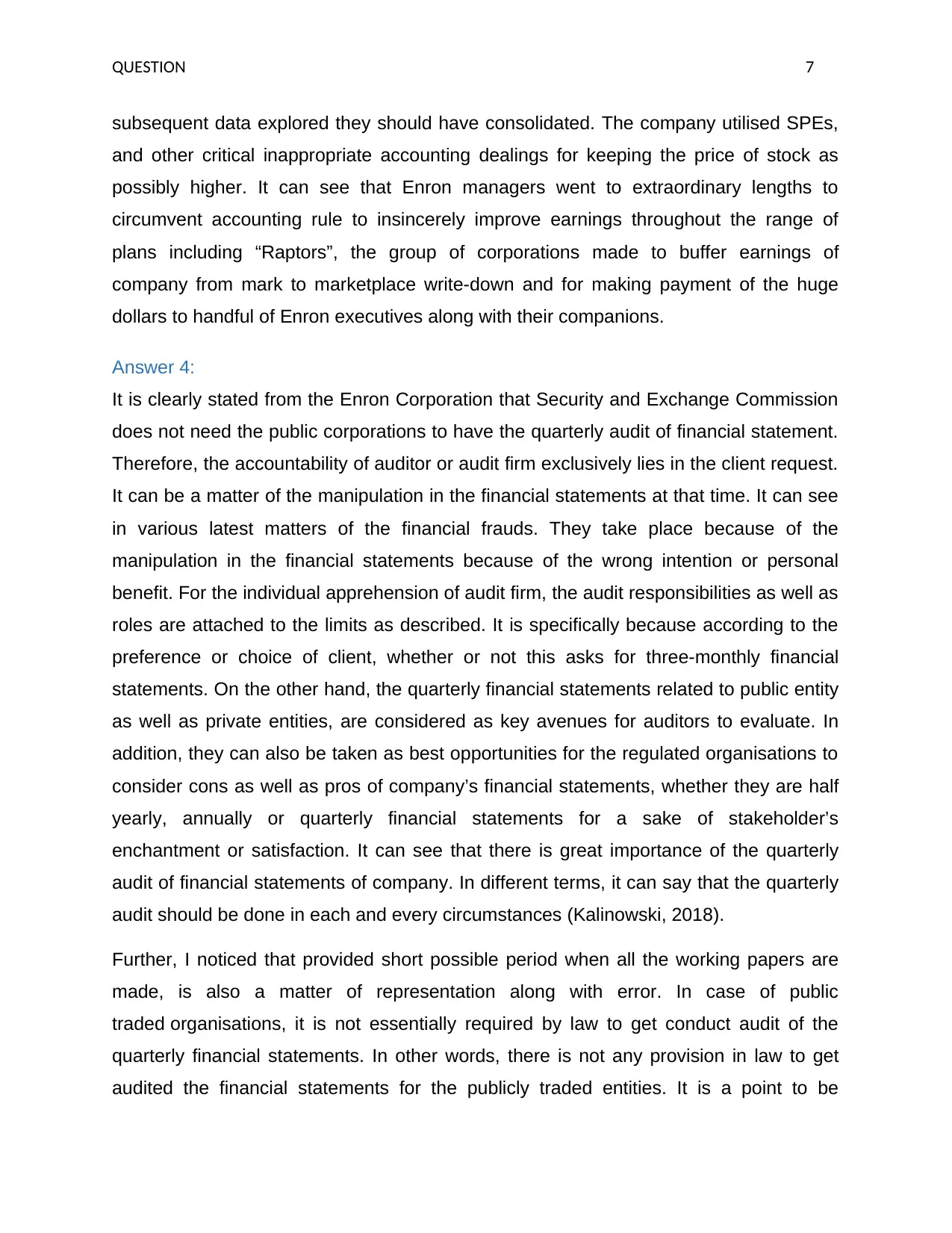
QUESTION 7
subsequent data explored they should have consolidated. The company utilised SPEs,
and other critical inappropriate accounting dealings for keeping the price of stock as
possibly higher. It can see that Enron managers went to extraordinary lengths to
circumvent accounting rule to insincerely improve earnings throughout the range of
plans including “Raptors”, the group of corporations made to buffer earnings of
company from mark to marketplace write-down and for making payment of the huge
dollars to handful of Enron executives along with their companions.
Answer 4:
It is clearly stated from the Enron Corporation that Security and Exchange Commission
does not need the public corporations to have the quarterly audit of financial statement.
Therefore, the accountability of auditor or audit firm exclusively lies in the client request.
It can be a matter of the manipulation in the financial statements at that time. It can see
in various latest matters of the financial frauds. They take place because of the
manipulation in the financial statements because of the wrong intention or personal
benefit. For the individual apprehension of audit firm, the audit responsibilities as well as
roles are attached to the limits as described. It is specifically because according to the
preference or choice of client, whether or not this asks for three-monthly financial
statements. On the other hand, the quarterly financial statements related to public entity
as well as private entities, are considered as key avenues for auditors to evaluate. In
addition, they can also be taken as best opportunities for the regulated organisations to
consider cons as well as pros of company’s financial statements, whether they are half
yearly, annually or quarterly financial statements for a sake of stakeholder’s
enchantment or satisfaction. It can see that there is great importance of the quarterly
audit of financial statements of company. In different terms, it can say that the quarterly
audit should be done in each and every circumstances (Kalinowski, 2018).
Further, I noticed that provided short possible period when all the working papers are
made, is also a matter of representation along with error. In case of public
traded organisations, it is not essentially required by law to get conduct audit of the
quarterly financial statements. In other words, there is not any provision in law to get
audited the financial statements for the publicly traded entities. It is a point to be
subsequent data explored they should have consolidated. The company utilised SPEs,
and other critical inappropriate accounting dealings for keeping the price of stock as
possibly higher. It can see that Enron managers went to extraordinary lengths to
circumvent accounting rule to insincerely improve earnings throughout the range of
plans including “Raptors”, the group of corporations made to buffer earnings of
company from mark to marketplace write-down and for making payment of the huge
dollars to handful of Enron executives along with their companions.
Answer 4:
It is clearly stated from the Enron Corporation that Security and Exchange Commission
does not need the public corporations to have the quarterly audit of financial statement.
Therefore, the accountability of auditor or audit firm exclusively lies in the client request.
It can be a matter of the manipulation in the financial statements at that time. It can see
in various latest matters of the financial frauds. They take place because of the
manipulation in the financial statements because of the wrong intention or personal
benefit. For the individual apprehension of audit firm, the audit responsibilities as well as
roles are attached to the limits as described. It is specifically because according to the
preference or choice of client, whether or not this asks for three-monthly financial
statements. On the other hand, the quarterly financial statements related to public entity
as well as private entities, are considered as key avenues for auditors to evaluate. In
addition, they can also be taken as best opportunities for the regulated organisations to
consider cons as well as pros of company’s financial statements, whether they are half
yearly, annually or quarterly financial statements for a sake of stakeholder’s
enchantment or satisfaction. It can see that there is great importance of the quarterly
audit of financial statements of company. In different terms, it can say that the quarterly
audit should be done in each and every circumstances (Kalinowski, 2018).
Further, I noticed that provided short possible period when all the working papers are
made, is also a matter of representation along with error. In case of public
traded organisations, it is not essentially required by law to get conduct audit of the
quarterly financial statements. In other words, there is not any provision in law to get
audited the financial statements for the publicly traded entities. It is a point to be
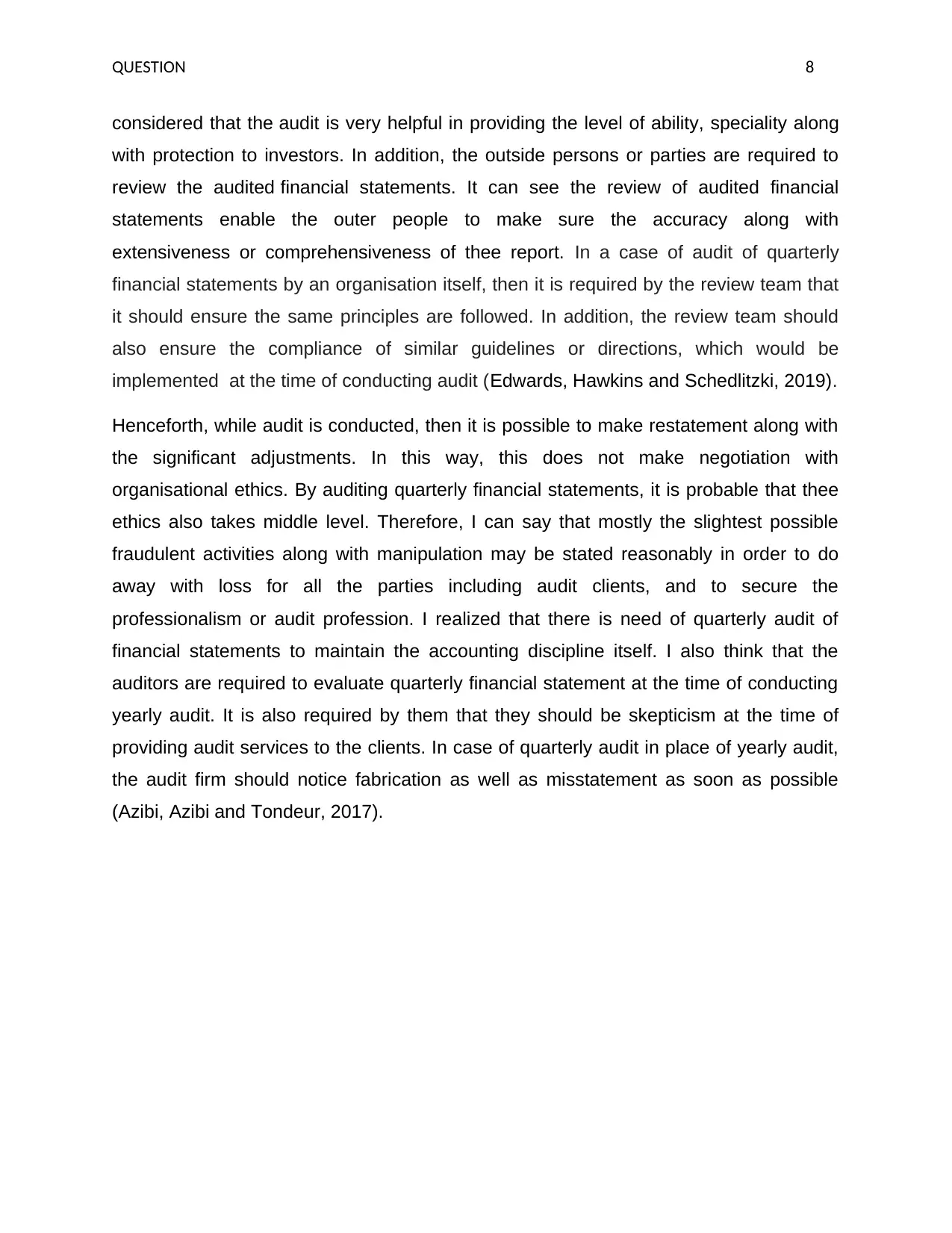
QUESTION 8
considered that the audit is very helpful in providing the level of ability, speciality along
with protection to investors. In addition, the outside persons or parties are required to
review the audited financial statements. It can see the review of audited financial
statements enable the outer people to make sure the accuracy along with
extensiveness or comprehensiveness of thee report. In a case of audit of quarterly
financial statements by an organisation itself, then it is required by the review team that
it should ensure the same principles are followed. In addition, the review team should
also ensure the compliance of similar guidelines or directions, which would be
implemented at the time of conducting audit (Edwards, Hawkins and Schedlitzki, 2019).
Henceforth, while audit is conducted, then it is possible to make restatement along with
the significant adjustments. In this way, this does not make negotiation with
organisational ethics. By auditing quarterly financial statements, it is probable that thee
ethics also takes middle level. Therefore, I can say that mostly the slightest possible
fraudulent activities along with manipulation may be stated reasonably in order to do
away with loss for all the parties including audit clients, and to secure the
professionalism or audit profession. I realized that there is need of quarterly audit of
financial statements to maintain the accounting discipline itself. I also think that the
auditors are required to evaluate quarterly financial statement at the time of conducting
yearly audit. It is also required by them that they should be skepticism at the time of
providing audit services to the clients. In case of quarterly audit in place of yearly audit,
the audit firm should notice fabrication as well as misstatement as soon as possible
(Azibi, Azibi and Tondeur, 2017).
considered that the audit is very helpful in providing the level of ability, speciality along
with protection to investors. In addition, the outside persons or parties are required to
review the audited financial statements. It can see the review of audited financial
statements enable the outer people to make sure the accuracy along with
extensiveness or comprehensiveness of thee report. In a case of audit of quarterly
financial statements by an organisation itself, then it is required by the review team that
it should ensure the same principles are followed. In addition, the review team should
also ensure the compliance of similar guidelines or directions, which would be
implemented at the time of conducting audit (Edwards, Hawkins and Schedlitzki, 2019).
Henceforth, while audit is conducted, then it is possible to make restatement along with
the significant adjustments. In this way, this does not make negotiation with
organisational ethics. By auditing quarterly financial statements, it is probable that thee
ethics also takes middle level. Therefore, I can say that mostly the slightest possible
fraudulent activities along with manipulation may be stated reasonably in order to do
away with loss for all the parties including audit clients, and to secure the
professionalism or audit profession. I realized that there is need of quarterly audit of
financial statements to maintain the accounting discipline itself. I also think that the
auditors are required to evaluate quarterly financial statement at the time of conducting
yearly audit. It is also required by them that they should be skepticism at the time of
providing audit services to the clients. In case of quarterly audit in place of yearly audit,
the audit firm should notice fabrication as well as misstatement as soon as possible
(Azibi, Azibi and Tondeur, 2017).
⊘ This is a preview!⊘
Do you want full access?
Subscribe today to unlock all pages.

Trusted by 1+ million students worldwide
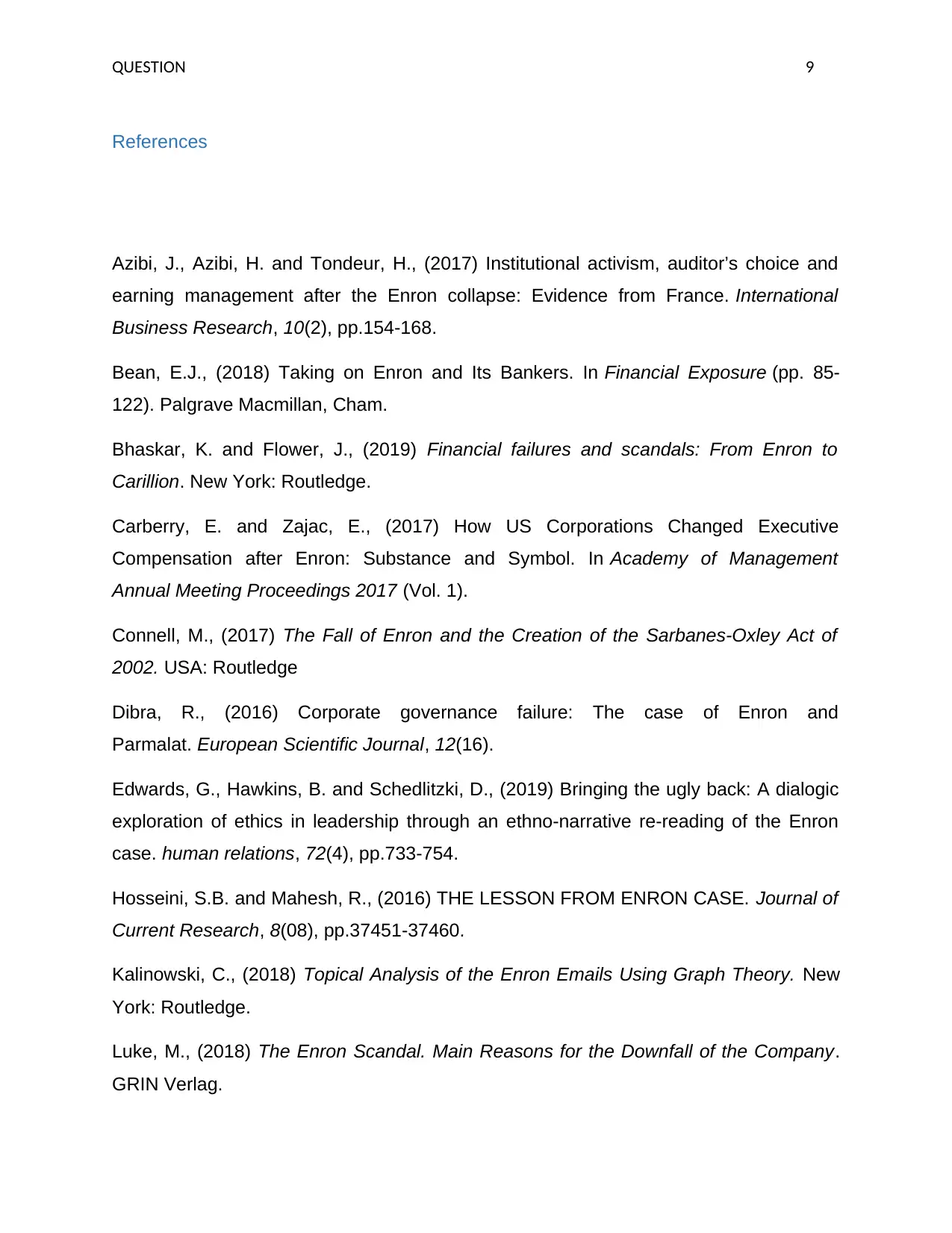
QUESTION 9
References
Azibi, J., Azibi, H. and Tondeur, H., (2017) Institutional activism, auditor’s choice and
earning management after the Enron collapse: Evidence from France. International
Business Research, 10(2), pp.154-168.
Bean, E.J., (2018) Taking on Enron and Its Bankers. In Financial Exposure (pp. 85-
122). Palgrave Macmillan, Cham.
Bhaskar, K. and Flower, J., (2019) Financial failures and scandals: From Enron to
Carillion. New York: Routledge.
Carberry, E. and Zajac, E., (2017) How US Corporations Changed Executive
Compensation after Enron: Substance and Symbol. In Academy of Management
Annual Meeting Proceedings 2017 (Vol. 1).
Connell, M., (2017) The Fall of Enron and the Creation of the Sarbanes-Oxley Act of
2002. USA: Routledge
Dibra, R., (2016) Corporate governance failure: The case of Enron and
Parmalat. European Scientific Journal, 12(16).
Edwards, G., Hawkins, B. and Schedlitzki, D., (2019) Bringing the ugly back: A dialogic
exploration of ethics in leadership through an ethno-narrative re-reading of the Enron
case. human relations, 72(4), pp.733-754.
Hosseini, S.B. and Mahesh, R., (2016) THE LESSON FROM ENRON CASE. Journal of
Current Research, 8(08), pp.37451-37460.
Kalinowski, C., (2018) Topical Analysis of the Enron Emails Using Graph Theory. New
York: Routledge.
Luke, M., (2018) The Enron Scandal. Main Reasons for the Downfall of the Company.
GRIN Verlag.
References
Azibi, J., Azibi, H. and Tondeur, H., (2017) Institutional activism, auditor’s choice and
earning management after the Enron collapse: Evidence from France. International
Business Research, 10(2), pp.154-168.
Bean, E.J., (2018) Taking on Enron and Its Bankers. In Financial Exposure (pp. 85-
122). Palgrave Macmillan, Cham.
Bhaskar, K. and Flower, J., (2019) Financial failures and scandals: From Enron to
Carillion. New York: Routledge.
Carberry, E. and Zajac, E., (2017) How US Corporations Changed Executive
Compensation after Enron: Substance and Symbol. In Academy of Management
Annual Meeting Proceedings 2017 (Vol. 1).
Connell, M., (2017) The Fall of Enron and the Creation of the Sarbanes-Oxley Act of
2002. USA: Routledge
Dibra, R., (2016) Corporate governance failure: The case of Enron and
Parmalat. European Scientific Journal, 12(16).
Edwards, G., Hawkins, B. and Schedlitzki, D., (2019) Bringing the ugly back: A dialogic
exploration of ethics in leadership through an ethno-narrative re-reading of the Enron
case. human relations, 72(4), pp.733-754.
Hosseini, S.B. and Mahesh, R., (2016) THE LESSON FROM ENRON CASE. Journal of
Current Research, 8(08), pp.37451-37460.
Kalinowski, C., (2018) Topical Analysis of the Enron Emails Using Graph Theory. New
York: Routledge.
Luke, M., (2018) The Enron Scandal. Main Reasons for the Downfall of the Company.
GRIN Verlag.
Paraphrase This Document
Need a fresh take? Get an instant paraphrase of this document with our AI Paraphraser
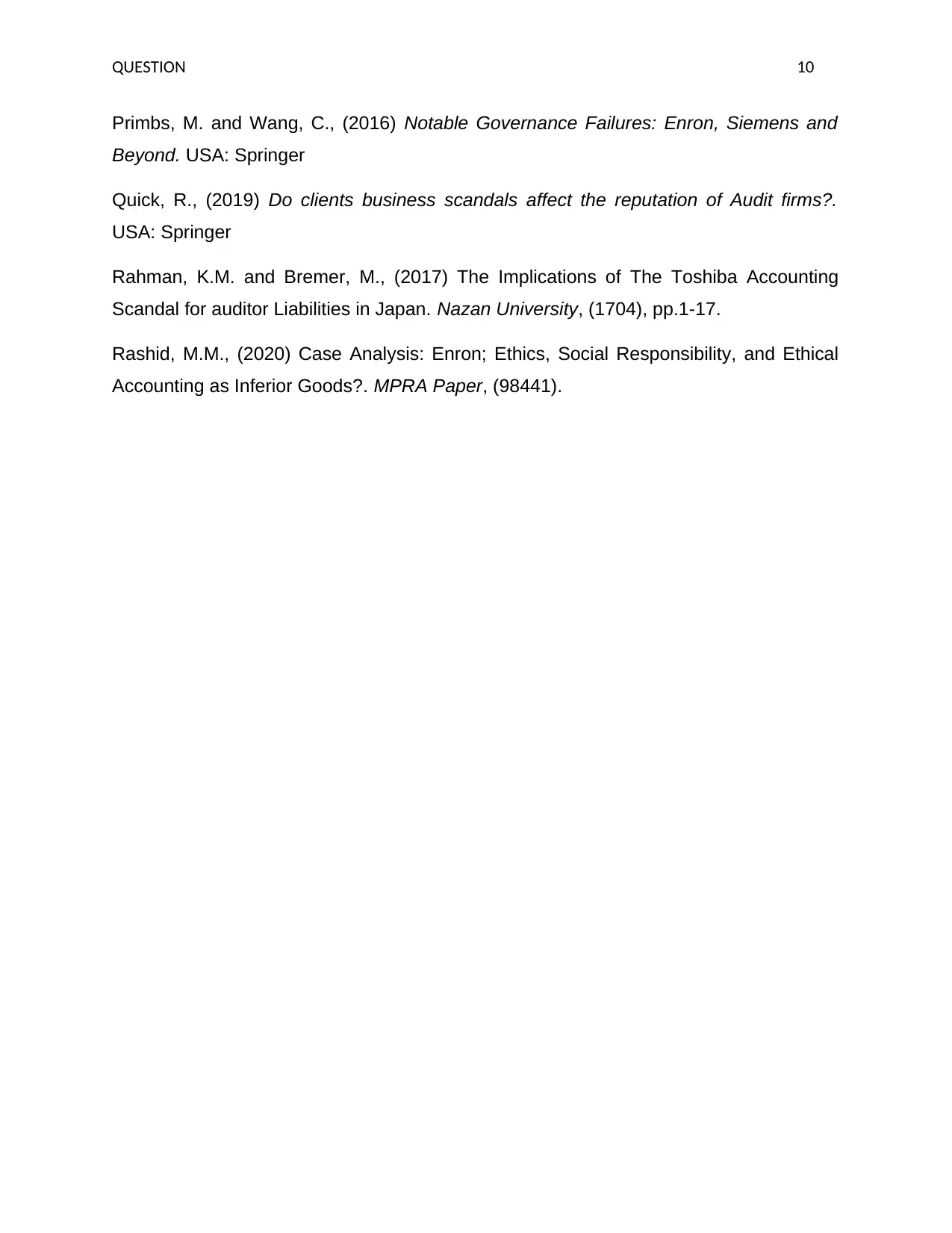
QUESTION 10
Primbs, M. and Wang, C., (2016) Notable Governance Failures: Enron, Siemens and
Beyond. USA: Springer
Quick, R., (2019) Do clients business scandals affect the reputation of Audit firms?.
USA: Springer
Rahman, K.M. and Bremer, M., (2017) The Implications of The Toshiba Accounting
Scandal for auditor Liabilities in Japan. Nazan University, (1704), pp.1-17.
Rashid, M.M., (2020) Case Analysis: Enron; Ethics, Social Responsibility, and Ethical
Accounting as Inferior Goods?. MPRA Paper, (98441).
Primbs, M. and Wang, C., (2016) Notable Governance Failures: Enron, Siemens and
Beyond. USA: Springer
Quick, R., (2019) Do clients business scandals affect the reputation of Audit firms?.
USA: Springer
Rahman, K.M. and Bremer, M., (2017) The Implications of The Toshiba Accounting
Scandal for auditor Liabilities in Japan. Nazan University, (1704), pp.1-17.
Rashid, M.M., (2020) Case Analysis: Enron; Ethics, Social Responsibility, and Ethical
Accounting as Inferior Goods?. MPRA Paper, (98441).
1 out of 11
Related Documents
Your All-in-One AI-Powered Toolkit for Academic Success.
+13062052269
info@desklib.com
Available 24*7 on WhatsApp / Email
![[object Object]](/_next/static/media/star-bottom.7253800d.svg)
Unlock your academic potential
Copyright © 2020–2025 A2Z Services. All Rights Reserved. Developed and managed by ZUCOL.





